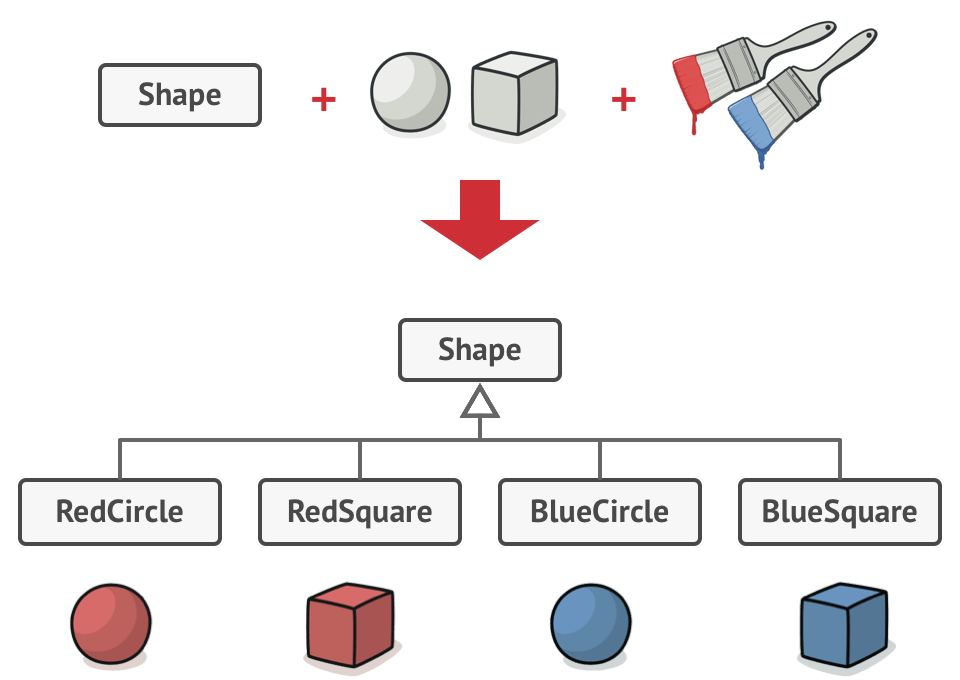设计模式入门指南(六):桥接模式
Bridge Pattern
桥接模式
别名又称为桥梁模式
概念
官方定义为将抽象和实现解耦,让它们可以独立变化,而更加通用的解释为当一个类存在两个或多个独立变化的维度时,我们可以通过组合的方式让它们(维度)可以独立扩展。
使用场景
- 类存在多个独立变化的维度&每个维度都需要进行扩展;
- 不希望通过使用继承or多继承导致系统类的个数急剧增加的场景;
实现方式
假如我们有一个形状类Shape,它从拓展出两个子类:圆形和方形,此时需要对颜色维度进行拓展时,我们很容易设计出以下这样的结构:

此时形状维度存在原型和方形,颜色维度存在红色和蓝色时,我们就需要创建4(m*n)个类才能覆盖所有的组合,如果我们新增形状或则颜色时,情况将会变得越来越复杂。此时桥接模式就可以登场了,我们可以通过抽取其中一个维度成为一个独立的层次,并通过组合的形式让初始类拥有其他维度的状态和行为,示意图如下:

Java Sample
public interface IColor {
void printColor()
}
public class Blue implements Color {
@Override
public void printColor() {
System.out.println("blue color");
}
}
public class Red implements Color {
@Override
public void printColor() {
System.out.println("red color");
}
}
public interface IShape {
void printShape()
}
public class Shape implements IShape {
private IColor color
public Circle(IColor color) {
this.color = color;
}
public void printShape() {}
}
public class Circle extends Shape {
private IColor color
public Circle(IColor color) {
this.color = color;
}
@Override
public void printShape() {
this.color.printColor()
System.out.println("circle Shape");
}
}
public class Square extends Shape {
private IColor color
public Circle(IColor color) {
this.color = color;
}
@Override
public void printShape() {
this.color.printColor()
System.out.println("Square Shape");
}
}
Circle redCircle = new Circle(new red())
Circle blueCircle = new Circle(new Blue())
Shape redShape = new Shape(new red())
Shape blueShape = new Shape(new Blue())
Golang Sample
type IColor interface {
printColor()
}
type Blue struct{}
func (Blue) printColor() {
fmt.Println("blue color")
}
type Red struct{}
func (Red) printColor() {
fmt.Println("red color")
}
type IShape interface {
printShape()
}
type Shape struct {
color IColor
}
type Circle struct {
Shape
}
func (circle Circle) printShape() {
circle.color.printColor()
fmt.Println("circle shape")
}
func BuildCircle(color IColor) IShape {
return Circle{Shape{color: color}}
}
type Square struct {
Shape
}
func (square Square) printShape() {
square.color.printColor()
fmt.Println("square shape")
}
func BuildSquare(color IColor) IShape {
return Square{Shape{color: color}}
}
func main() {
redCircle := BuildCircle(new(Red))
blueCircle := BuildCircle(new(Blue))
redSquare := BuildSquare(new(Red))
blueSquare := BuildSquare(new(Blue))
redCircle.printShape()
blueCircle.printShape()
redSquare.printShape()
blueSquare.printShape()
}
总结反思
通过组合关系来替代继承关系,避免继承层次的暴涨,和我们提到的组合优于继承的设计原则非常接近。官方对桥接模式的定义比较难理解,我们可以简单地:
- Shape为抽象部分,提供高层控制逻辑,依赖于完成底层实际工作的实现对象;
- Circle和Square为具体抽象部分,通过实现接口与不同的实现交互;
- IColor为实现部分,为所有具体实现声明通用接口;
- Red和Blue为具体实现部分;
Shape和IColor之间的组合关系,就像是桥梁一样连接着两个维度之间的关系,这就是桥接模式的精髓。
类图

总结反思
- 桥接模式的代码实现很简单,但是官方的定义理解比较有点难度,应用场景也不多。而另一种理解方式更加简单,类似组合优于继承设计原则,应用场景也比较多。不管哪种理解方式,他们的代码结构都是相同的,都是类之间的组合关系;
- 与多层继承不同,桥接模式将多个独立变化的维度设计为多个独立的继承结构,并且在抽象层建立一个抽象关联用于连接多个独立的继承结构。即用抽象关联来取代了多层继承,将类之间的静态关系转化为动态的组合关系。但该模式可能会使代码在可读性上会受到一定的影响;
附
1 回复


